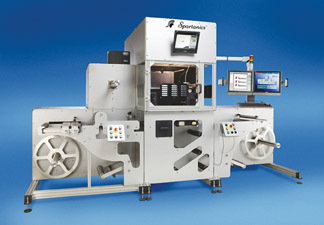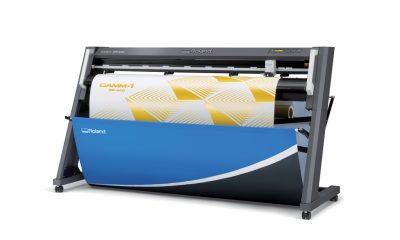Graphics Printing
Published
12 years agoon
We have chosen a profession that is by its nature a capital-intensive industry, and that can present a problem.
Graphic software to take in clients’ files requires on average a thousand dollars of upgrades every other year, and the actual workstation (Mac or PC) needs to be replaced every three or four years. Naturally, the newer software is optimized on the newest boxes. You can almost hear the cost accumulating: cha ching!
We have chosen a profession that is by its nature a capital-intensive industry, and that can present a problem.
Graphic software to take in clients’ files requires on average a thousand dollars of upgrades every other year, and the actual workstation (Mac or PC) needs to be replaced every three or four years. Naturally, the newer software is optimized on the newest boxes. You can almost hear the cost accumulating: cha ching!
Secondly, printing devices range from $20,000 to a couple of million dollars in cost. This cost does not stay stagnant, and digital equipment should produce a return on investment (ROI) within three years. Devices may become out of date or too expensive to maintain after that time frame.
Lastly, the service costs can pile up for all printers. Yet being without a service contract is similar to playing roulette with your client. Even if we put together a third-party service network to take care of printers, problems arise.
So, how can you maximize your investments on equipment and service, while maintaining a level of expertise and production? As you can imagine, beauty is in the eye of the beholder. Original equipment manufacturers (OEMs) have the statistics and logic behind new equipment purchases, while smaller printers often take a used equipment direction. The importance of knowing what you are getting into is important for both approaches in this economy.
What experts say about new equipment
Buying a new digital printer has the advantage of current technology, a warranty time frame to work out the bugs, and access to techs within the OEM, though hefty service contracts are required on the high-end production devices.
Bill Kujawa, president of BK Marketing, says, “Buying new is a difficult ROI unless you have a client or a contract. Buying new will also make you paranoid because a newer, faster, better presses will soon be in the market.” Therefore, buy new for specific needs of a client or clients. Build it and they will come is a philosophy that’s long gone. Rather, build it when the need is present.
Joe Shondel, past president of SGIA, echoes Bill’s message that relate to high-speed digital presses. “Unless your business is profitable and growing, these types of fees (service contracts) are very difficult to amortize over the course of a year and still many repairs are still not covered 100%.” Monthly costs for debt service and service contracts can be a huge nut to crack, though offer fantastic throughput if the work is consistently there.
Thoughts on used equipment
Because digital is constantly changing, buying used probably puts you two generations behind the latest and greatest. From a service and support viewpoint, if it is your first piece of equipment, used is likely to be a disaster. If you are adding to an existing fleet of presses or replacing a press, adding a used press of the same make and model would seem to be a safer bet.
“Basically, I would frame the decision around a business strategy,” says Bob Travis, owner of Inkworks. “If I am a new entrant to digital printing, expecting to capture new opportunities, I would suggest new equipment. It is difficult to be compelling with second or third generation technology. If the strategy is to convert existing business or expand current digital business, investing in used equipment that matches existing capability, would allow for a seamless implementation at lower cost.”
A monthly nut for the addition of a $250,000 device would be approximately $15,000 (debt service, service contract, one additional employee). This could equate to an additional $300,000 of sales yearly to deal with this expense. Per month, this would equate to 250 sheets of 4 x 8-ft product. For a smaller company, down time could be a scary cash drain, though larger companies could handle the peaks and valleys of such choices.
Chip Basse, president of Albert Basse Associates, directs his thoughts to the client, “Our clients are demanding higher quality than the quality that some of the older machines are capable of, so that is part of our decision making.”
Buying new equipment has many positives, as John Heiser, president of Heiser Sign and Graphic Services, has said. With new equipment, warranty support is usually better. New equipment, the latest technology (and refinements), and reliability follow. Negatively, the price and uncertainties of your return on investment are also part of the buy new decision.
The actual make up of the company and the personality of the ownership plays a large part in the new vs. used choice. Mike Altreuter, VP with Global Imaging, elaborates: “Having sold both new and used digital equipment during the last seven years, I recognize the benefits of both. New buyers tend to be risk averse, they need to have guaranteed service response time, want the latest features to stay ahead of the competition, want a tight relationship with a manufacturer in order to develop niche end products or get unique matched component warranties or the like by working with a manufacturer and partner companies.”
Opportunities for large format, used, digital equipment are vast. The variables rely on the personalities of the decision makers, service, and replacement parts issues, cost, reliability, image technology and more. The perfect circumstance for a used equipment purchase is when it is the second device to be on hand, ready when more capacity is required.
Operators know the good, bad, and ugly already. “I say yes to used equipment as long I have the back-up from the manufacturer and the manufacturer can give you the equipment’s history,” says Ralph Rhein, VP of operations at Duracolor. A detailed history must be provided. OEMs tend not to be in the used market, just as you might see in the automobile world. It is just too risky.
Regarding service scenarios, the consensus is that an internal person should be used to absorb maintenance and/or simple fixes. At Albert Basse, a qualified maintenance technician is on staff to primarily service screen equipment, facilities, etc. The technician is especially good with electronics for testing and controls. With proper training and knowledge, the house technician can gain more knowledge and be key to repairs.
The pre-owned market does have its challenges. According to John Heiser, the marketing of used equipment is difficult because prices are too high. This is usually for equipment that is well used and the owner has recouped the investment and depreciation many times over, yet still expects to recoup a large amount of the original price when selling it. More operations that currently have thought about additional equipment would purchase used equipment if it were reasonably priced.
Mike Altreuter likes the used direction. “I would personally purchase 90% of my digital equipment as used. One reason is that buying a used piece that has been in production generally means the printer has settled in. Most issues that companies face with a new printer happen in the first 30-60 days. A used piece has already gone through that. If you save $50,000 to $150,000 on the purchase price, and there is a possibility of needing to spend $10,000 to $15,000 in repairs, is it a good deal? My answer is a resounding yes, but not everyone sees it that way. The key is for buyers to be honest with themselves.”
Ford Bowers, VP at Miller Zell concurs. “If you are looking to add redundant production presses and want them to have like print quality/productivity, then buying the same machine you purchased last year, even though this time it’s used, is sometimes a better option. You are already familiar with it and can assess its condition better.”
Points on service conracts
Service contracts go hand in hand with the decision to buy used or new. Even continuing the service contract from warranty status is in question. Will the OEM take on a service contract of a used device, and at what cost? Many will create a service contract, though the equipment must be certified before the contract is written. This may cost $5,000 to $10,000, depending on the printer. Many OEMs will not continue a warranty when sold to a third party. The printing equipment may be performing perfectly on the seller’s floor, but it may have issues upon delivery.
Responses regarding service contracts for used equipment elicited the most emotion. Rhein does not believe in service contracts because, in his opinion, they are all over priced: “In my 13 years of owning many digital machines, we never had a higher repair cost than the yearly fees of a service contract. We never exceeded half the cost of a contract. You need a well-trained person on your staff to handle minor repairs. In this way, you can save money by not buying a service contract.”
Mike Altreur agrees. Typically, a service contract on a piece of digital equipment is roughly 10% of the list price of the machine, he adds. There are many companies that will gladly pay this premium because they require a guarantee for response time from the manufacturer and it makes sense for their volumes and business model. However, most companies would be better off paying straight Time and Materials, he asserts. He suggests that to put the monthly cost of a service contract in the bank, as there will be the inevitable repair. At the end of the year, a significant savings should be expected. The downside is that the response rate may be less for time and material clients, and you are at the pricing whim of the slowest tech. That in it self could get frustrating.
Because there are so many different devices within even the same OEM, it has been a long, slow road for any national company to organize support of used equipment. Most of the best support and service comes from past manufactures’ employees operating as small service contractors. These arrangements are harder to find, though.
The economic realities of service are a real issue in running a printing business. Joe Shondel chimes in: “Our printer’s yearly contract was $50,000. Unless your business is profitable and growing, these types of fees are difficult to amortize over the course of a year and still many repairs are not covered completely. A viable alternative to direct factory service is needed to bring these costs down to realistic levels.”
“The level of comfort with do-it-yourself staff and their experience really determines if you would go with third party help,” Bowers says. “The more experience, the more likely a shop will try to save money. Whether warranties are voided from using other techs or inks is a big issue.”
The availability of software upgrades, and patch/fixes, when service contracts are not used can affect the productivity. Variation in digital equipment is equal to the perception regarding used and new large-format, digital printers. The personality of the origination seems to be the deciding factor. Savings can be had, though you need a staff that can deal with service.
Rick Mandel is president/owner of the Mandel Company, a 120 year old,
family-owned graphics firm. He is CEO of the Screentech Division, specializing in large-format color separations prepared for the screen printing industry, large-format color separations for the P-O-P industry and large-format digital printing. He has been a speaker for SGIA, SPTF, and POPAI and is a member of the Academy of Screen Printing Technology. He is a
20-year member of SGIA.

Subscribe

Magazine
Get the most important news
and business ideas from Screenprinting Magazine.
Most Popular
-

 Art, Ad, or Alchemy1 month ago
Art, Ad, or Alchemy1 month agoF&I Printing Is Everywhere!
-

 Case Studies1 month ago
Case Studies1 month agoHigh-Density Inks Help Specialty Printing Take Center Stage
-

 Andy MacDougall1 month ago
Andy MacDougall1 month agoFunctional and Industrial Printing is EVERYWHERE!
-

 Columns2 weeks ago
Columns2 weeks ago8 Marketing Mistakes Not to Make When Promoting Your Screen Printing Services Online
-

 Editor's Note2 weeks ago
Editor's Note2 weeks agoLivin’ the High Life
-

 Thomas Trimingham2 months ago
Thomas Trimingham2 months ago“Magic” Marketing for Screen Printing Shops
-

 Marshall Atkinson2 weeks ago
Marshall Atkinson2 weeks agoHow to Create a Winning Culture in Your Screen-Printing Business
-

 News & Trends1 month ago
News & Trends1 month agoWhat Are ZALPHAS and How Can You Serve Them in Your Print Business?






